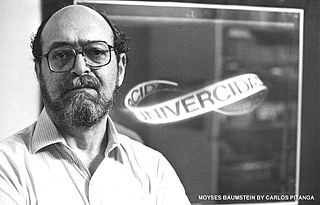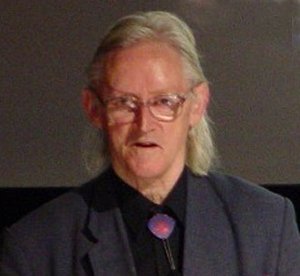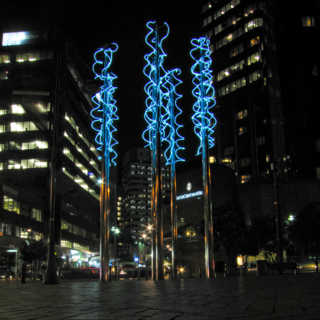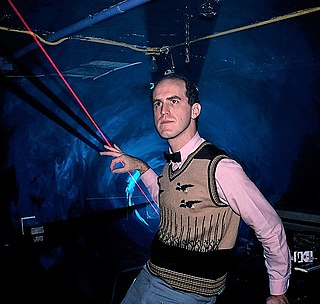
Holography is a technique that enables a wavefront to be recorded and later reconstructed. It is best known as a method of generating real three-dimensional images, but also has a wide range of other applications. In principle, it is possible to make a hologram for any type of wave.
Lloyd Cross is an American physicist and holographer.
The MIT Museum, founded in 1971, is located at the Massachusetts Institute of Technology in Cambridge, Massachusetts. It hosts collections of holography, technology-related artworks, artificial intelligence, architecture, robotics, maritime history, and the history of MIT. Its holography collection of 1800 pieces is the largest in the world, though only a few selections from it are usually exhibited. As of 2023, works by the kinetic artist Arthur Ganson are the largest long-running displays. There is a regular program of temporary special exhibitions, often on the intersections of art and technology.

Moysés Baumstein was a Brazilian artist. Baumstein worked in many fields: from literary creation to painting, from film making to holography. He was driven by singular curiosity and diligence and typified as a "Renaissance Man" joining science with art throughout his accomplishments.

Stephen Anthony Benton was the E. Rudge ('48) and Nancy Allen Professor of Media & Sciences, and the Director for Center for Advanced Visual Studies (CAVS) at Massachusetts Institute of Technology. He was the inventor of the rainbow hologram and a pioneer in medical imaging and fine arts holography. Benton held 14 patents in optical physics and photography, and taught media arts and sciences at MIT.

Australian Holographics was a laboratory based in Adelaide, South Australia. It was established in 1989 with the specific objective to produce high quality large format holograms. After two years of research and development, the company began commercial operations in 1991. The laboratory eventually shut down in 1998.
Susan Silas is a visual artist working primarily in video, sculpture and photography. Her work, through self-portraiture, examines the meaning of embodiment, the index in representation, and the evolution of our understanding of the self. She is interested in the aging body, gender roles, the fragility of sentient being and the potential outcome of the creation of idealized selves through bio-technology and artificial intelligence.

Nicholas (Nick) John Phillips was an English physicist, notable for the development of photochemical processing techniques for the colour hologram. Holograms typically used to have low signal-to-noise ratios, and Phillips is credited as the pioneer of silver halide holographic processing techniques for producing high-quality reflection holograms.
Susanna J. Coffey is an American artist and educator. She is the F. H. Sellers Professor in Painting at the School of the Art Institute of Chicago and lives and works in New York City. She was elected a member the National Academy of Design in 1999.
The Musée de l'Holographie was a notable museum of holography located in Paris, France. The museum was established in 1980, and located for some years in the Forum des Halles. According to S. Johnston, it closed its doors in 1994. But in fact, it was in April 1996. The museum's collections are now shown in touring exhibits in France and around the world.
Specular holography is a technique for making three dimensional imagery by controlling the motion of specular glints on a two-dimensional surface. The image is made of many specularities and has the appearance of a 3D surface-stippling made of dots of light. Unlike conventional wavefront holograms, specular holograms do not depend on wave optics, photographic media, or lasers.
Specialized Enterprise Holography Ltd. (SE Holography) is a company that specializes in production of holograms and holographic security elements. Holography, a member-company of the EDAPS Consortium, is among the founders of the security printing industry in Ukraine. Established in 2000 with the support of the International Centre the Institute of Applied Optics on behalf of the National Academy of Sciences of Ukraine. Holography Ltd. is a member of the International Hologram Manufacturers Association (IHMA), a member of the International Society for Optical Engineering (SPIE) and a member of the Counterfeiting Intelligence Bureau at the International Chamber of Commerce of Ukraine.

Yves Gentet is a French engineer and artist, known for the invention of a creative method of holograms in colour Ultimate and a 3D holographic printer Chimera.

Dieter Jung is a German artist working in the field of holography, painting and installation art. He lives and works in Berlin.

William Franklin Culbert was a New Zealand artist, notable for his use of light in painting, photography, sculpture and installation work, as well as his use of found and recycled materials.
Holography is often used as a plot device in science fiction, appearing in a wide range of books, films, television series, animation and video games. Probably the first reference is by Isaac Asimov in his Foundation series staritng in 1951.

Jason Sapan, also known as Dr. Laser is a holographer and actor who is the founder of Holographic Studios, the world's oldest gallery of holography, located in the borough of Manhattan in New York City. He is one of the pioneers of holography, and has also worked as an educator, recording engineer, artist, blogger, and actor. He has created portrait holograms of Andy Warhol, President Bill Clinton, Isaac Asimov, NYC Mayor Ed Koch, Prime Minister Edward Heath, Pierre Cardin, Sally Jessy Raphael, John Kenneth Galbraith, Phyllis Diller, Billy Idol, The Smothers Brothers, Phil Donahue, and John Cage. His corporate clientele include commissions for Mitsubishi, AT&T, Tag Heuer, Goodyear, IBM and NYU Medical Center.

Holographic Studios, located in the borough of Manhattan in New York City, is the world's oldest gallery of holography. It was founded in 1979 by Jason Sapan, one of the pioneers of holography. The storefront level gallery features the world's largest collection of motion image integral holograms. On display in the gallery are a variety of different types of holographic images, including a collection of celebrity hologram portraits. There are also cylindrical 360° floating images, multiple image holograms that change as you walk by, and computer generated holograms as well as a selection of novelty hologram items and stickers. Directly below the gallery is the laser laboratory where holograms are created. Holographic Studios creates custom holograms, holographic portraits, offers classes, and operates tours.
Margaret Benyon,, was a British artist. Trained as a painter, she was one of the first artists to use holography as a medium and had her first solo show of holograms in 1969. She was appointed to the Order of the British Empire in 2000 for her service to art and has been called "the mother of British holography".

Matthew Schreiber is an American artist who is known for his work in holography and for his large scale laser light sculptures. Matthew Schreiber produces work in a wide variety of mediums, including drawing, performance, sculpture, video, and light. Recurring subjects within Schreiber's work center on novelty, the occult, and spectacle by using tools of physics, technology and perception. He has exhibited his work internationally, and most recently at large music festivals, an example of which can be found in his 2018 installation at Dark MOFO in Tasmania, in which Schreiber created a massive laser-light installation that completely immersed viewers.












